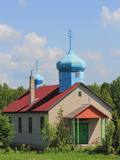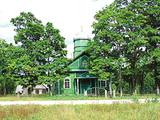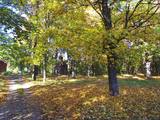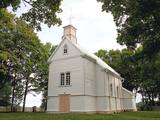| Нo | Название | Описание |
|---|---|---|
|
Atrodas Jasmuižas austrumdaļā. Dievnams celts 1815. g., bet pārbūvēts 1932. g. |
||
|
Iespaidīga koka celtne un izcils koka arhitektūras piemērs, kuru pamanīs katrs Plateļu apmeklētājs! Plateļu baznīca ir viens no Lietuvas vecākajiem koka dievnamiem. Pašreiz redzamais ir būvēts 1744. g., bet zvanu tornis – 1899. g. Dienvidos no baznīcas plešas Plateļu muižas parks. |
||
|
Atrodas Celtnieku un Z. Mauriņas ielu krustojumā. Dievnams uzcelts 2000. gadā modernās arhitektūras formās (arhitekti Aija un Andris Kokini), kas simbolizē Noasa šķirstu vai zviedru laivas, kas atnesušas kristīgo ticību. |
||
|
Деревянная церковь была построена местными ремесленниками на средства графов Плятеров в период с 1655-го по 1658-й годы как миниатюрная однонефная базилика. Эта церковь – неповторимый культурно-исторический памятник – считается одной из старейших деревянных церквей Латгалии. Алтарную резьбу по дереву в барокальных формах создали мастера Стелмужской школы резчиков по дереву . В боковом алтаре находится картина «Св. Мария Магдалена» середины 18-го века. Церковь на нынешнее место – правый берег Даугавы – была перевезена в 1698-м году. Здание неоднократно восстанавливалось – в 1890-м и 1918-м годах. Вокруг церкви – каменная ограда, построенная в конце 17-го века с отдельно стоящей колокольней, построенной в середине 19-го века и отреставрированной в 2002-м году. Учитывая многие информативные источники можно считать, что Индрицкий приход является самым старым в Латгалии. |
||
|
Mūsdienās redzamo (pēc skaita – trešo) baznīcu cēla laikā no 1835. - 1837. g. (ampīra stilā) Mārča Sāruma vadībā. Arī šīs ēkas projektēšanā par paraugu bija ņemts Pievolgas vācu baznīcu veidols, tādēļ tā līdzīga Dzērbenes luterāņu baznīcai. Dievnama altāri rotā Otto Donnera fon Rihtera glezna “Kristus debesbraukšana” (1898. g.). E. Martina firmā būvētās 10 reģistru ērģeles (1901. g.) darbojās arī šodien. Pie Drustu baznīcas atrodas 1932. g. atklātais un formās iespaidīgais (E. Kuraua firmas veidots) granīta piemineklis 1. pasaules karā un Latvijas Brīvības cīņās kritušo piemiņai. Nelielā baznīcas sienas nišā novietota piemiņas plāksne komunisma terora upuriem. |
||
|
Oldest (building started in 1227) stone church in Estonia. Unique christening stone in the Baltic States. Old painting on the walls. |
||
|
Моленная Вайновской старообрядческой общины построена в 1980
году на месте прежней, которая сгорела от удара молнии. Первоначально
моленная была одной из крупнейших в Латгалии, одновременно в храме
могло находиться около 2 000 человек.
|
||
|
Vienīgā baznīca nacionālā parka teritorijā. Tā atrodas Kirblas (Kirbla) ciemā – uz neliela pacēluma, kas Baltijas ledus ezera laikā bijusi sala, kuru no visām pusēm ietvēris ūdens. Kirblas baznīcas pirmsākumi ir meklējami 16. gs. un par tās celtniecību saglabājušies dažādi interesanti nostāsti. Tas ir viens no mazākajiem Igaunijas dievnamiem (29 x 11 m). |
||
|
Jau pēc dievnama veidola var spriest, ka vēl ne tik sen – padomju laikos ēka bija izmantota citām vajadzībām. Pēc 2. pasaules kara to atsavināja draudzei, bet torni – uzspridzināja, dievnamā ierīkojot noliktavu. 20. gs. deviņdesmitajos gados draudze uzsāka baznīcas atjaunotni un tagad tā kalpo savam pamatmērķim. |
||
|
Meklējama pilsētas centrā - Tirgus laukumā 11. Dievnams uzcelts 1886. g. Ēkā atrodas vairāki nozīmīgi mākslas pieminekļi – gleznas, krucifikss (18. gs.) u.c. Baznīcas dārzā apskatāma skulptūra “Latgales māte” (tēlnieks B. Buls) un piemineklis politiski represēto piemiņai (tēlniece V. Dzintare). Baznīca ir apskatāma arī no iekšpuses. |
||
|
Моленная Исмерской старообрядческой общины.
В 1912 году на краю Исмерского озера (по утвержденному в
Витебске плану) было начато строительство моленной на
пожертвования местных жителей. В течение двух лет моленная
была построена. Исмерский приход существует с 1861 года.
|
||
|
Расположена между озерами Банужи и Илзес. Считаетсяобразцом неповторимого деревянного строительства. Построена в 1780 г. Церковь возведена в технике строительства сруба и вплоть до начала 20 в. имеласоломенную крышу, которуюзаменили деревянной гонтовой крышей. |
||
|
Первую церковь в Вецпиебалге построили в 1345 году, а следующую – в 1839 – 1845 году под руководством ливского строительного предпринимателя Марциса Сарума. Ее уничтожили осенью 1944 года и восстановили в 1995 - 1997 годах (архитектор А. Скуйиня). В алтарной части церкви расположена картина Ю.Егера "Христос ходит по земле Пиебалги". Рядом с храмом расположен камень в память о политически репрессированных. |
||
|
Часовня усадьбы Пуша – местный памятник архитектуры,
построенный в 18 веке. Находится в парке усадьбы Пуша. Парк разбит
в середине 19 века и является национальным памятником архитектуры.
|
||
|
Построенное в простых формах одноэтажное здание, над входом в которое на крыше установлен крест. И хотя сама община Питрагса основана в 1890 году, храм построен в 1902 году, а восстанавливался в 1925 - 1926 гг. после пожара во время Первой мировой войны, а также во время независимой Латвии. |
||
|
Проезжая по северному берегу Саукского озера (где перекресток на Клауци), сквозь деревья просматривается Саукская лютеранская церковь. Это третий храм на этом месте. Открытие состоялось в 1827 году, осмотру подлежит г.о. извне. Церковный алтарь украшен скульптурами апостола Петра и Павла и алтарной иконой Й.Деринга «Иисус у креста с Марией и Иосифом». Орган - работа елгавских ремесленников, но трубы органа - из Саукас.
|
||
|
Atrodas Daugavas prospektā 10, starp Rīgas – Daugavpils šoseju (A 6) un Kalēju ielu. Dievnams celts laikā no 1931. - 1933. g. (arhitekts: Pēteris Kundziņš). Padomju gados tajā bija izvietota Latvijas Valsts bibliotēkas grāmatu glabātava. Pateicoties draudzes aktivitātēm 1989. g., ēku atjaunoja. Tagad tā kalpo savam pamatmērķim. |
||
|
Пушский Римско-католический костёл Пресвятой Троицы
был построен в 1743 году на средства помещика Шадурскиса и
передан на попечение иезуитов. Пушский приход был основан в
Миссии иезуитов (миссией Шадурскиса). Костёл имеет три
алтаря и орган латышского органостроителя Я. Гремзе.
|
||
|
Находится в южной части поселка Гудениеки. Храм, который можно видеть сегодня, возводился в период с 1930 по 1947 гг. Составная часть алтаря – созданное на рубеже XVII – XVIII вв. украшение суббатскими мастерами – скульптуры ангелов (единственные такие в декоративной скульптуре барокко Курземских церквей), которые прикреплены к стенам здания по обе стороны алтаря. Возможно, что и фигура Спасителя на кресте с лежащим у ног агнцом является работой этих мастеров. Как церковь приобрела работы суббатских мастеров – неизвестно. Храм можно осмотреть изнутри. |
||
|
This small wooden church with fragments of a metal gate is on the side of the road in the village of Ruduški. It is not open to visitors on a daily basis. |
||





